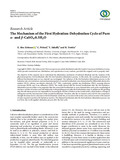Zitierlink:
http://dx.doi.org/10.25819/ubsi/9945Dateien zu dieser Ressource:
| Datei | Beschreibung | Größe | Format | |
|---|---|---|---|---|
| The_mechanism_of_the_first_hydration-dehydration_cycle.pdf | 2.46 MB | Adobe PDF |  Öffnen/Anzeigen |
| Dokumentart: | Article | Titel: | The mechanism of the first hydration-dehydration cycle of pure α- and β-CaSO4•0.5H2O | AutorInn(en): | Abu Zeitoun, Edres Pritzel, Christian Sakalli, Yilmaz Trettin, Reinhard |
Institut: | Fakultät IV - Naturwissenschaftlich-Technische Fakultät | Schlagwörter: | HemiHydrate, Hydrogenation, Dehydrogenation | DDC-Sachgruppe: | 540 Chemie | GHBS-Notation: | UPK UPB UTND UYF |
Erscheinungsjahr: | 2020 | Publikationsjahr: | 2021 | Auch erschienen: | Advances in Materials Science and Engineerin ; Vol. 2020, Article ID 1732621. - https://doi.org/10.1155/2020/1732621 | Zusammenfassung: | The objective of this research was to understand the dehydration mechanism of technical dihydrate and the variation of the physical properties of β-hemihydrate after the first hydration-dehydration process. In this study, the recycling mechanism of different hemihydrate types as raw material was investigated. The influence of the first hydration-dehydration process on the hydration rate, microstructure, and mechanical properties of recycled hemihydrate were characterized by differential calorimetric analysis (DCA), calcium ion-selective electrode (Ca2+-ISE), conductivity, particle size distribution (PSD), scanning electron microscopy (SEM), and X-ray diffraction (XRD). The results showed that the formed hemihydrate after the first hydration-dehydration process differs in its properties than the unrecycled hemihydrate in some characteristics such as the morphological structure, number of surface, and side defects due to the grinding process after the first hydration step. In addition to the grinding step, the calcination process was responsible for increasing the number of defects on the crystal surface, which leads to a change in setting time and the microstructure of the recycled hemihydrate. Therefore, after the 1st reaction cycle of β-HH, the compressive strength decreases due to a decrease in the hemihydrate crystal size, an increase in the surface area, and an increase in the amount of water required to perform the hydration reaction. The obtained hemihydrate after the first hydration-dehydration process was in β form due to the applied calcination process after the first cycle. |
Beschreibung: | Finanziert aus dem Open-Access-Publikationsfonds der Universität Siegen für Zeitschriftenartikel |
DOI: | http://dx.doi.org/10.25819/ubsi/9945 | URN: | urn:nbn:de:hbz:467-19322 | URI: | https://dspace.ub.uni-siegen.de/handle/ubsi/1932 | Lizenz: | http://creativecommons.org/publicdomain/zero/1.0/ |
| Enthalten in den Sammlungen: | Geförderte Open-Access-Publikationen |
Diese Ressource ist urheberrechtlich geschützt. |
Seitenansichten
459
checked on 30.11.2024
Download(s)
236
checked on 30.11.2024
Google ScholarTM
Prüfe
Prüfe
Diese Ressource wurde unter folgender Copyright-Bestimmung veröffentlicht: Lizenz von Creative Commons


